There are a number of threats facing small to medium sized livestock farmers in Europe. Beef and sheepmeat, being as they are so dependent on CAP payments, are especially vulnerable to cost-benefit analysis involving the EU. TTIP too threatens these producers.
Let’s take the example of Ireland. Professor Alan Matthews made a very strong case for a move of land use from livestock to forestry, based on Ireland’s EU climate change commitments.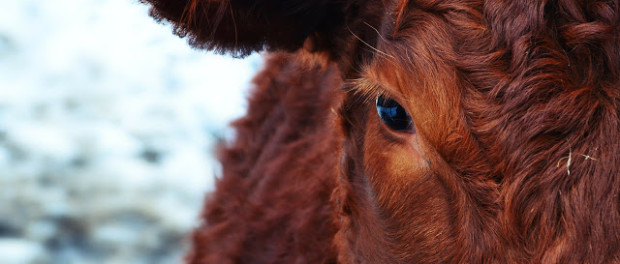
The Irish Farmer’s Association (IFA) Ireland’s largest farming organisation, is incensed with this suggestion – claiming Matthews “lacks credibility” .
This is errant nonsense. Political economist Matthews is perhaps the most respected commentator on EU agri-food policy issues. He is Professor Emeritus of European agricultural policy at Trinity College Dublin, Ireland’s most prestigious academic institution. For these and other reasons, he was chosen to sit on the recently formed Climate Change advisory Council, which is tasked with overseeing Ireland’s transition to a low carbon economy.
It seems the issue the IFA have is that he’s not a choir boy in their chorus. They are not used to people having any power over agri-food decisions who don’t agree with them.
His point is that under new EU rules from 2020, forestry can be used as an offset, whereas now, livestock’s full emissions are not measured. This, along with the level of beef and sheepmeat subsidy dependence (75% on average for livestock in Ireland, with some areas even more dependent) makes forestry uncompetitive at present, but not after 2020. So, it is argued, we need changes now to prepare for these new realities in 2020, in a context of a transition to a low carbon economy.
While it can be argued that political economists lack the sociological nuance to fully grasp rural life, there is in fact a third way. This third way is not in any significant sense being developed in Ireland, despite how it might suit the island. It is also given but a bracket’s worth of reference in Matthews’ own recent writings. This approach is agroforestry.
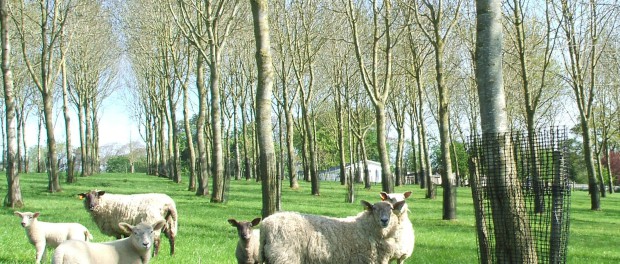
Agroforestry, combined with some organic farming techniques should urgently be investigated as a possible climate change adaptation and mitigation strategy, which in turn could keep rural Ireland populated, vibrant, producing beef and sheepmeat, while also increasing the number of tress on the land massively.
First the organic dimension. Crop rotations, feed grown on farms practicing genuine crop rotations (and not the farce of crop diversification), the use of farm yard manure and clover for fertility, done at a genuinely apt stocking rate builds soil carbon and reduce the use of fossil fuels.
Projects should be established to measured carbon building on a trial set of organic and conventional farms.
The slightly lower stocking rate in organic is important for other EU targets such as the water frameworks and biodiversity directives, as we showed in this animation about the BERAS initiative in the Baltic region.
In other words, eventually all livestock farming will have to square up to the fact that there is a lower carrying capacity for the land than the current allowable maximum. Indeed when current EU Commissioner Phil Hogan was Minister for the Environment in Ireland, he signed in legislation to increase the nitrogen load (i.e. number of animals on the land), despite a N compliance failure rate of nearly half of all farms inspected.
Agroforestry, if taken up in sufficient numbers, fused with these organic approaches, could transform the carbon footprint of Irish agriculture.
In Loughgall, Northern Ireland, there is a long running silviopastural agroforestry experiment, in place since 1989. (in the Republic, there is also a new agroforestry trail in Bantry)
Ash Trees were planted at 5m x 5m spacing giving 400/ha into managed ryegrass pasture (160kgNha-1). This is grazed with sheep from March to November.
Incredibly, there is no reduction in available grass for the sheep for 12 years. And around 12 years in, the Ash trees come on as a crop themselves. They too are almost (but not quite) as productive as a woodland plantation in this set up.
Professor Jim McAdam of the Agri-Food and Biosciences Institute, Belfast, outlines the trials.
On the AFBI Agroforestry Unit at Loughgall, protected ash have been planted at 400 trees ha-1 in 1989 into managed ryegrass pasture (160kgNha-1) and grazed with sheep from March to November. The system is being compared with agricultural and woodland controls.
By 2011 trees in agroforestry were about 14m tall only marginally below those in the woodland situation. What was more important was the diameter of the trees – in the agroforestry, the ash had a diameter at breast height (DBH) of 25cm – whereas in the equivalent woodland planting of 13cm. Ash trees were thinned out in 2004 when the average tree height was 13m. The wood (7.2m3 from 1.87ha) was sold for £245/m3 (£943/ha) into the hurley market. A further thinning of 20m3 for the same market is also planned for 2013.
Trees can be successfully established and grown in pasture and the impact on normal grassland management practice is minimal. Pasture growth and livestock production were not reduced until the trees were over 12 years old. The system has been proved to deliver a range of “ecosystem services” from grassland – carbon storage to offset against agricultural emissions, biodiversity, nutrient retention in soils and reduced water pollution, animal welfare benefits and so on.
Minor tweaking to compensate for the relative lag years from 11 to 14 (when the trees are bigger but not yet a crop, and when the grazing area is slightly reduced) may need to come in, but that’s a very minor consideration in the greater scheme of things.
400 trees per hectare would make a massive impact on Ireland’s GHG emissions. That’s in a ryrgrass trial – imagine an organic sward with a dozen plus plants including N fixing clover?
The Ecological Focus Areas (EFAs) option of greening under Pillar 1 of the CAP specifically supports agroforestry as an option, and it was an option chosen by our Department of Agriculture.
Not every Member State chose an agroforestry option for Greening and EFA s – for example, the UK did not.
Encouragingly, combination of forestry and pasture is one of the 12 enterprises supported by the the 2014-2020 Afforestation Grant and Premium Scheme in Ireland. This scheme recommends between 400 and 1000 trees per hectare.

Oh and the crop that this new vision of farming and forestry fused would yield? Hurleys. In Ireland, there is a very popular indigenous sport called hurling. It is played with sticks (a little like hockey sticks) made from ash.
There is something very locally resilient – and satisfying on so many fronts – about using this wood to make the tools for a local sport. Local employment, local industry, keeping fit, helping culture blossom, improving biodiversity, building soil carbon, providing food sustainably, the list goes on.
With the Ash die back disease, it is understandably more difficult to get supports for planting ash trees. The scheme above for example emphasises oak, sycamore and cherry, though exceptions can be made. There are plenty of arguments to be made for each of these three tree types.
But in interviewing Jim McAdam of Loughgall, the spacing between trees in agroforestry may be enough to actually hinder the spread of the disease. This too merits investigation.
A radical move, completely from livestock over to forestry would in turn radically alter the landscape and population patterns of Ireland. While there may be positives in this – sometimes landscapes should change and climate change is fostering radical changes anyway – it would be a rupture. The psyche of rural Ireland would be changed, changed utterly. Ireland has a long relationship with livestock: the word for road in the native Irish language is bóthar – which translates as the cow path. Similarly, Ireland was one of the last places in Europe to get money. When it finally did, the currency was pegged to the value of one cow. Today, there are about 140,000 farms, and over 11 million sheep and cattle on the island – over twice the number of people.
 Agroforestry can offer a third way, one with a myriad of interconnected benefits. A way that keeps farmers farming, but also farming trees. And there ways to integrate other animals too -turkeys, shorter cattle (eg Dexters), cereal crops, and then there is the garden of eden like forest gardening, doable even in the harsh cold wetness of the west of Ireland.
Agroforestry can offer a third way, one with a myriad of interconnected benefits. A way that keeps farmers farming, but also farming trees. And there ways to integrate other animals too -turkeys, shorter cattle (eg Dexters), cereal crops, and then there is the garden of eden like forest gardening, doable even in the harsh cold wetness of the west of Ireland.
Kes Clarke (pictured) runs forest gardening courses from her smallholding in Clare in the west of Ireland. There, almost 100 deliberate, commercially valuable plants, many of which are multifunctional, providing ecosystem services such as nitrogen fixing, ground cover, mulch, mineral accumulation, or attracting pollinators.
Clarke created a terraced garden to maximise her site’s forest gardening potential. On this south facing slope, some areas get and need maximum light, others are are quite shaded, bordering a mature hedgerow.
“This forest garden is arranged in vertical layers, so there is the potential for greater productivity in a lesser surface area.” Clarke says.
She outlines the layers:
- Ground cover plants shelter and protect the earth, provide habitat for small mammals and insects and can be a source of food and medicine.
- Perennials can be vegetables, edible flowers, fodder, compost accelerators, mineral accumulators, insect encouragers, dye plants, flavourings, a source of natural medicine.
- Fruiting climbers can be trained through trees and shrubs and over fences to further maximise space efficiency.
- The shrub layer offers edible fruits, nuts, leaves and seeds, aromatic properties, insect encouragement, nitrogen fixing fertility, medicinal qualities.
- The upper or canopy layer of the forest garden consists of deciduous trees that offer shelter, shade, leaf mould, fodder, mycorrhizal associations, fuel, building materials, wildlife habitats, fruits, nuts, seeds, edible leaves and sap.
So a planet-friendly diet is possible through the various stands of agroforestry: meat, cereal crops and the cornucopia of forest gardening.
In the simpler more straightforward approach, as exemplified by the Loughgall silviopastural trials, many farms in Ireland could be suitable.
If even 30,000 farms – a typical number for agri-environmental schemes in Ireland – were to take on silviopastural agroforestry (which can work for cattle, poultry, sheep and pigs) an extra 38 million trees would be planted in Ireland, using the Loughgall stocking rates and presuming a farm size of 30 ha. (All of the figures here are deliberately conservative – farm size, number of trees, number of apt farms).
Of course much more needs to be figured out, as regards the socio-environmental impact of such a transformation. The two aforementioned payment options in Ireland, while positive, are unlikely to attract large numbers in this CAP round.
But 400 tress per hectare is a hell of a head start, in working out a system to improve the climate change performance of Ireland and Ireland’s farms. (Ireland is very likely to miss its climate change targets and agri-food is the main culprit).
Perhaps Alan Matthews could have a go at the calculations required for making agroforestry make sense in an Irish agri-food context?
Fighting climate change through mutton and hurling, while saving the essentially agricultural soul and spirit of rural Ireland. Its an intriguing opportunity; it should be developed more thoroughly, with a view to making it a serious offering for the next CAP; because it could, to echo a popular phrase, change everything.



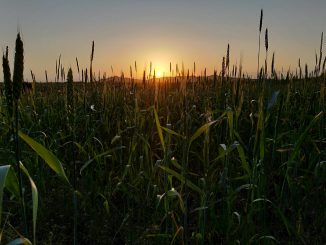
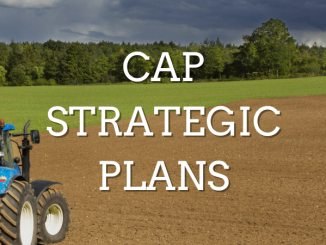
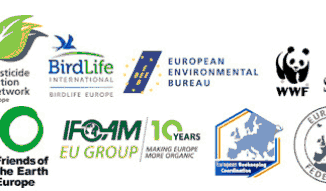
1 Trackback / Pingback
Comments are closed.